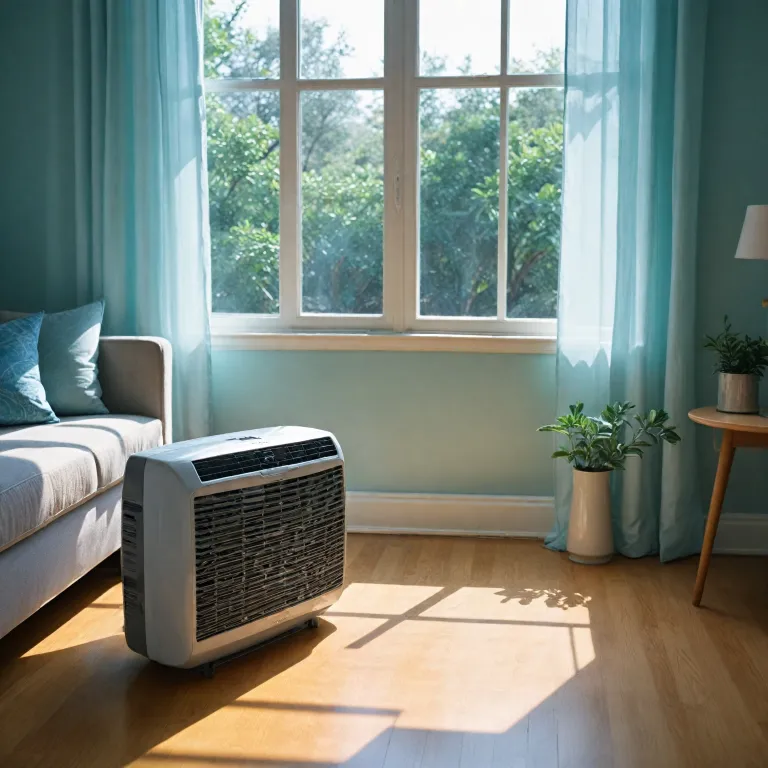Why Venting is Crucial for Portable Air Conditioners
The Importance of Proper Venting for Portable Air Conditioners
The necessity of venting portable air conditioners cannot be emphasized enough. Venting is crucial for these units to function effectively, as it allows hot air generated during the cooling process to be expelled from the room. Many customers aren't aware that without proper venting, a portable air conditioner will struggle to cool a space efficiently and might even cause the room to become warmer. This is because the unit requires a path to discharge warm air, typically through an exhaust hose leading to a window or appropriate vent.
Portable air conditioners are designed to remove heat from the air inside your home and expel it outside, leaving a stream of cool air to recirculate within the room. The concept is simple: the unit pulls in warm air, cools it down through its internal refrigeration system, and then releases the now cool air back into the space. Concurrently, the hot air is funneled outside, ensuring that the indoor temperature remains comfortable.
Key Components of Venting
To achieve this effective expulsion of warm air, portable ACs rely heavily on components such as the exhaust hose and a window kit. These pieces make it easy to create a duct passageway for air to travel through. The hose connects the portable unit to the outside via a window vent, ensuring that exhaust air doesn’t mix with the cooled air inside. This isolation of hot and cool air streams is key to the unit's efficiency.
For more insights into air conditioning systems and the significance of flexible ducting in portable units, you can
learn about flexible ducting.
Establishing the correct venting process is fundamental for the performance of any portable air conditioner. Therefore, paying close attention to these elements can greatly impact how well your space remains cool, especially in hot weather. Subsequent sections will delve into various venting options available, challenges you might encounter, and innovative solutions for unique spaces.
Different Venting Options Available
Exploring Various Venting Options for Portable Air Conditioners
When it comes to venting your portable air conditioner, choosing the right method is crucial to ensure maximum cooling efficiency. Depending on your needs and room design, there are several venting options available that can help you manage the exchange of cool and warm air effectively.
- Window Kits: These are the most common and straightforward option for venting portable AC units. A window kit typically includes a window bracket and an exhaust hose. The window bracket is adjusted to fit within your window frame, and the hose is connected to the exhaust outlet on the air conditioner to channel hot air outside your room. This option is perfect for temporary setups and easy to install.
- Sliding Window Kits: Similar to standard window kits, sliding window kits are specifically designed for windows that slide to open. These kits are essential for homes with horizontal sliding windows, utilizing a durable panel that fits snugly to ensure efficient ventilation.
- Dryer Vents: Although not as common, using a dryer vent can be an alternative solution for venting a portable air conditioner. This setup requires an existing dryer vent opening that can accommodate the conditioner hose for exhausting hot air outside. However, it is important to ensure a tight fit to prevent backflow of warm air back into the room.
- Ventless Models: Some innovative portable ACs are designed without the need for traditional venting. These units use evaporative cooling technology, which is suitable for areas with low humidity. Nonetheless, they may not provide the same level of cooling power as vented units in humid or very hot conditions.
For more information about how you can further optimize your HVAC system, check out
the benefits of flexible rectangular ductwork in portable air conditioners. Exploring these flexible and efficient ductwork options can significantly enhance your cooling experience, offering versatility and efficiency in diverse spaces.
Considering these venting options can help in making well-informed decisions that align with your cooling requirements, room configuration, and personal preferences, ensuring an enhanced air conditioning experience.
Step-by-Step Guide to Installing a Vent Kit
Three Fundamental Steps to Install a Vent Kit
Installing a vent kit for your portable air conditioner is crucial to ensure efficient cooling and optimal performance. Not only does it allow the hot air generated by the unit to be expelled outside, but it also helps in maintaining a cooler environment inside the room. Here are three practical steps to guide you through the installation process.
Step 1: Choose the Right Window Kit
Begin by selecting a window kit that suits your specific model of portable air conditioner. Many units come equipped with a manufacturer-supplied kit, but if not, kits can be purchased separately. Make sure your kit includes a window bracket, exhaust hose, and any necessary attachments. For sliding windows, ensuring you have a compatible kit is essential for a snug fit, as this will prevent warm air from seeping back into the room.
Step 2: Prepare the Window and Fit the Bracket
Next, open your window and clean the area where the bracket will be placed. This ensures maximum adherence and stability. Position the window bracket in the open space, adjusting it to fit the size of your window. Secure it in place either using screws or, for a more temporary solution, using adhesive-based methods if your window type requires it. This step is instrumental in guaranteeing that the warm air exhaust is directed properly, without leaks, back into the room.
Step 3: Connect the Vent Hose Securely
Finally, connect the exhaust hose to both the back of the portable ac unit and the window kit. Secure the connections tightly to prevent any air leaks. If your setup includes a dryer vent or involves use of flexible ductwork, make sure these components are firmly in place and check for any obstructions that might hinder the exhaust flow. It's also advisable to periodically inspect the connections to maintain efficient venting over time.
Ensuring proper installation can dramatically affect your unit's cooling capabilities. For a deeper dive into how your air conditioner's mechanics work with these venting components, check out the
understanding the mechanics of a portable air conditioner for more insights.
Common Venting Challenges and Solutions
Addressing Common Obstacles in Venting Setup
Setting up the vent for a portable air conditioner is crucial for efficient cooling in any room. However, customers often encounter a few common challenges that may affect how well the unit performs. Here’s an easy read to help you tackle some of these issues.
- Incorrect Hose Placement: Ensure the exhaust hose is correctly placed to allow warm air to leave the room. Improper placement can lead to inefficient cooling as hot air might seep back in. Double-check that your air conditioner hose is securely connected to the window kit or sliding window bracket for secure venting.
- Leaky Connections: Leaks in the venting connections can lead to a loss of cool air. Inspect the conditioner hose and window kit connections for any gaps. Sealing these connections with appropriate materials can prevent air from seeping through, keeping the room comfortably cool.
- Blocked Airflow: Proper venting requires unimpeded airflow for effective cooling. Make sure the exhaust hose is not obstructed by furniture or other items. Keep the path clear so the unit can efficiently expel hot air from the room.
- Adapting to Different Window Types: Not all windows are built the same. Portable window air conditioners might come with a standard kit, but if you have unique window setups, it may require some modifications. Consider flexible window vent attachments or tailor-made solutions for sliding or casement windows.
Facing these challenges can be frustrating, but with the right knowledge and tools, your portable ACs can perform optimally. These solutions aim to enhance your air conditioner’s efficiency and longevity, ensuring you stay cool and comfortable even in hot conditions.
Innovative Venting Solutions for Unique Spaces
Considering Alternative Venting Approaches for Distinctive Settings
When it comes to portable air conditioners, venting is a crucial aspect not only for effectiveness but also for ensuring longevity of the unit. While traditional methods like using a window vent kit might work well for standard settings, unique spaces may require innovative approaches.
For rooms without suitable windows or those with sliding windows, flexible venting options are essential to allow the air conditioner to expel exhaust air effectively. Some solutions customers have found successful include:
- Using a dryer vent: If your room has access to a dryer vent, this could be an ideal alternative for venting the hot air generated by portable air conditioners. Simply connect the exhaust hose to the available outlet for a seamless setup.
- Ceiling or door vents: In spaces lacking a window, installing a ceiling or a door vent could facilitate proper air circulation. Ensure the vent allows the portable unit to expel the warm air efficiently out of the room.
- Vent hoods: A vent hood may be used where traditional kits aren’t feasible. By creating a discharge outlet, such as through existing ducts, these hoods can guide the expelled air out of the space.
Besides the above solutions, ensure that the exhaust hose is as straight as possible and any bends or twists are minimized. This reduces the pressure on the system and aids in efficient cooling of the room.
Innovative venting solutions become vital in environments that do not conform to typical setups. If you encounter challenges with where to vent your portable AC, remember to adapt by using creative alternatives that make the installation seamless yet effective. By leveraging different venting strategies, you can optimize your unit's performance even in non-conventional spaces.
Maintenance Tips for Efficient Venting
Keeping Your Portable Air Conditioner Optimally Vented
Regular maintenance of your portable air conditioner ensures efficient cooling. Proper venting plays a crucial role, not only in maximizing the cooling effectiveness but also in extending the lifespan of the unit. Here's how you can maintain the venting system of your portable unit.
- Regular Inspection: Frequently check the vent hose for any blockages or kinks. A bent hose can restrict airflow, limiting cooling efficiency. Ensure the exhaust hose is properly attached to both the unit and the window kit for optimal performance.
- Clean the Exhaust Hose: Over time, dust and debris can accumulate inside the vent hose. It's advisable to detach the hose and give it a thorough clean, particularly after long periods of use. This helps maintain an unobstructed passage for heat to escape.
- Seal Properly: Examine the window vent and ensure it is adequately sealed. Any gaps can let warm air seep back into the room, counteracting the cooling effect. Use materials like foam or weather-stripping tape to seal any visible gaps between the window bracket and the sliding window.
- Check Unit Filters and Clean Regularly: Dusty filters can block airflow, forcing the unit to work harder. Make it a routine to clean or replace air filters, as clean filters contribute to an effective cooling system.
- Seasonal Storage: If you plan to store your portable air conditioner during colder months, make sure to clean and dry the vent kit and exhaust hose before storing them. This prevents mold and mildew from forming.
Routine care of your portable ac’s venting system not only facilitates cooling but also lowers energy consumption and reduces wear and tear on the unit. This ensures customers are getting the most out of their investment in portable air conditioners.

